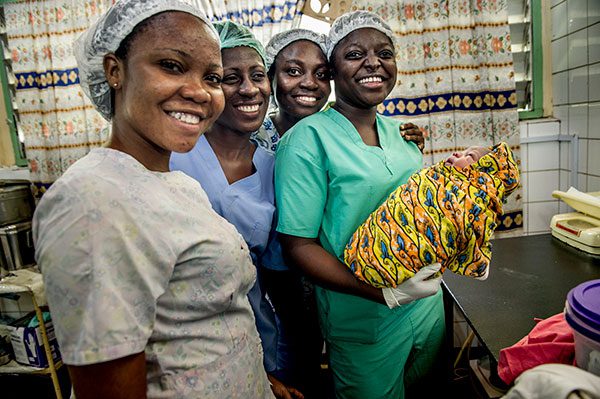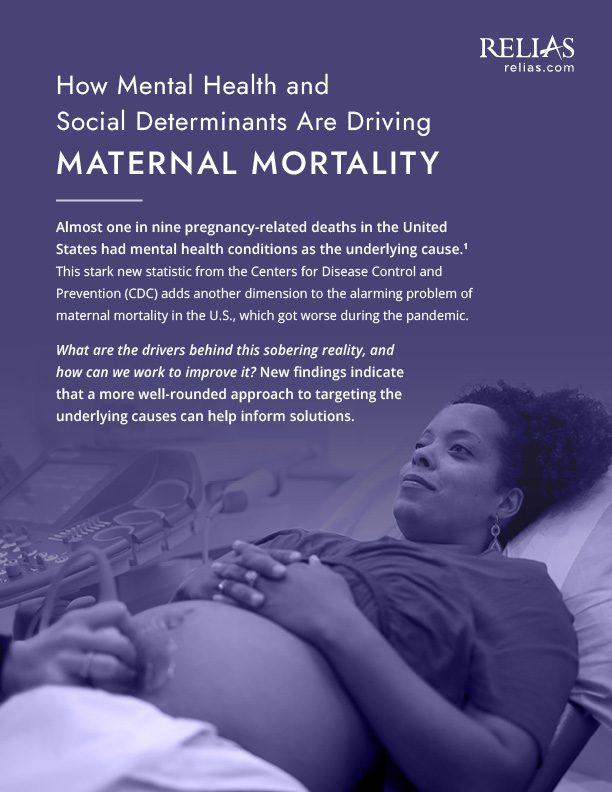Jhpiego, an affiliate of Johns Hopkins University, was originally the Johns Hopkins Program for International Education in Gynecology and Obstetrics — which explains its unusual name. Pronounced JAH-PIE-GO, the organization has worked to help low and middle-income countries advance maternal care since its founding in 1973. Jhpiego’s work with midwives abroad highlights differences among countries yet reveals commonalities applicable to maternal care both domestically and internationally.

(Photo courtesy of Jhpiego, Karen Kasmauski)
Today, Jhpiego is still pursuing its mission of providing reproductive health training and empowering healthcare providers with tools and methods to improve maternal and child health and manage infectious diseases in over 30 countries. We recently spoke with Anne Hyre, leader of Jhpiego’s Antenatal/Postnatal Research Collective (ARC) project, which seeks to help develop and implement new models of maternal health care to improve both patient and provider experiences.
Hyre has worked to advance reproductive health and as a nurse and midwife in locales as far-ranging as Russia and central and southeast Asia. She worked in Indonesia for 15 years, serving as Senior Midwifery Advisor and later, Country Director. At the time of this interview, Hyre was working in Kenya with the Gates-funded ARC project.
Maternal care abroad: status and needs
Jhpiego’s work focuses on low-resource settings, where adequate equipment and technology are often not available. In many of these regions — which include active Jhpiego programs across Africa, Asia, and the Americas — midwives have an important role in maternal care. Often the only maternal care providers available, and often without adequate tools and resources, midwives can bear a heavy burden of responsibility.
Obstacles to receiving care
Both prenatal and postnatal care can present challenges in countries where it may be a hardship for pregnant women to travel to a care facility. “In many countries and settings where we work, pregnancy is a very frightening experience,” explained Hyre. “Mothers are often not supported, and women are nervous, anxious, and fearful. To receive care, they might need to walk for a long time, sit in very uncomfortable conditions, and wait for hours to be seen by a midwife. By the time they are seen, the visit might last for only a few minutes, and it may only be focused on taking her blood pressure, measuring her abdomen, and listening to the fetal heart rate, with very little communication between the midwife and the patient.” Mothers might receive iron tablets or a malaria test if available but rarely receive all recommended components of prenatal care.
No compelling reason to return
Without a compelling reason to return, many patients don’t come back for subsequent visits. Hyre explained that efforts to encourage mothers to deliver in a health facility, presumably a safer environment than delivering at home, have not led to improved health outcomes due to the quality and conditions of facilities available. They are often crowded, not particularly clean, and lacking in privacy.
Despite these deterrents, perhaps the most important considerations are sociocultural rather than physical. Attempts to medicalize the birth process have often overlooked what mothers need and want from a human-centered perspective. Hyre provided the example of mothers in Ethiopia, who have a cultural tradition of staying home for six weeks after a birth, making it unlikely for them to attend postnatal care visits.
To accommodate this cultural norm, Jhpiego is exploring the use of self-care technology to enable women to monitor their own blood pressure, temperature, and overall health status at home.
Maternal care in the U.S.: status and needs
As a high-income country, the U.S. offers an abundance of resources to help ensure safe maternal care. However, the U.S. has an alarmingly high maternal mortality rate despite the advantages available. While global maternal mortality has declined by 40% since 1990, rates in the U.S. have worsened over the same period, rising from 10 maternal deaths per 100,000 live births in 1990 to 17.3 in 2018.
Factors driving negative U.S. maternal outcomes include variations in care that cause providers to miss signs of pregnancy risks, a social preference for C-sections that can lead to maternal health complications, and social determinants such as a lack of access to care, financial obstacles, and preexisting conditions that are prevalent in low-income areas. Additional problems stem from an undersupply of maternal care providers in widespread maternity care deserts, a lack of provider home visits, and no paid parental leave.
Because the large majority of global maternal deaths occur in lower-income countries, and many higher-income countries have reduced maternal deaths to rates much lower than the U.S., maternal mortality is clearly a problem that some countries have had greater success in preventing. The U.S. can look to other high-income countries for solutions, but it can also look to lower-income countries for practices to emulate.
What can we learn from international efforts?
In some of the most difficult circumstances for maternal care across the world, Jhpiego has learned that great improvement is possible. Research on different approaches to determine what is successful in different regions has resulted in a deeper understanding of what mothers need during pregnancy and birth, depending on their traditions and culture.
Understanding cultural perspectives can lead to a more holistic view of pregnancy and birth that transcends providing supplies and resources and focuses on the mother’s experience of care — listening not just to what they need, but to what they want. For example, in some cultures, a successful model of care might involve a group setting that offers more opportunity for peer-to-peer support.
Another learning opportunity comes from the important role of the midwife. The American Journal of Managed Care reported that the U.S. and Canada have the lowest number of midwives among developed nations, but in many instances, midwives “have been found to be comparable or preferable to physician-led care in terms of mother and baby outcomes and a more efficient use of health care resources.” The World Health Organization also recommends midwives as “an evidence-based approach to reducing maternal mortality.”
In many countries — both low- and high-income — midwives commonly provide maternal and prenatal care. Whereas obstetricians and physicians can intervene when pregnancy complications occur, they typically provide care in hospital settings, creating limitations for patients who may not have access to that level of care.
For example, in the U.S., Medicaid covers 43% of all deliveries but only provides 60 days of postpartum coverage. And even though the Affordable Care Act in the U.S. covers midwifery care, the supply of midwives is low, and it is often unavailable.
Examining differences and commonalities in maternal care abroad
Despite facing the same challenge of reducing maternal mortality, the U.S. differs distinctly in causes of maternal deaths from countries where Jhpiego works. Hyre described the scarcity of resources that still exists in many parts of the world where Jhpiego’s work to provide basic services such as ultrasound and access to safe surgical care is ongoing. In some areas, C-sections are not yet an option, while reducing unnecessary C-sections is now a concern in the U.S. due to risks caused by overuse of the procedure by some providers.
Additionally, health education and resources are not equally available to all in the U.S., whereas in lower-income countries, education and resource issues may exist alongside access issues for most of a population. Cultural support also differs for pregnant mothers. Hyre noted that in the U.S., pregnancy is usually a cause for celebration, while in other parts of the world, it can be an experience fraught with uncertainty and a lack of support.
Yet ultimately, one approach that providers can learn and apply from Jhpiego’s work abroad is what Hyre described as applying the study of behavior design to better understand how patients experience care. Despite their best efforts and intentions, providers may overlook a population’s needs. Providing care in ways that align with cultural preferences is key to reaching populations that do not receive adequate care within the models currently in place. To do this, support for providers may be as important as support for those receiving care.
Support and education: equally important for providers and patients
In Jhpiego’s work to implement new models of care, providers’ needs are front and center. Imagine serving as a midwife in a place where you may lack a clean facility, supplies, equipment, or reliable transportation. Jhpiego has focused on the skills and knowledge of midwives, supplies, and equipment, and has more recently begun to focus on provider well-being. Hyre points out that midwives may undergo a great deal of stress, trauma, and anxiety, yet they are expected to provide empathetic, respectful care to women in difficult conditions.
A new Jhpiego initiative, Club Courage, attempts to address caregivers’ emotional needs through informally structured regular group support activities with the idea that a greater sense of well-being for midwives will enable them to provide better care for patients.
“Getting midwives talking and supporting each other to help them feel more supported, better about their jobs, and that they have a network of people to reach out to — sharing the fact they are not alone — translates into better care for clients. And if it does nothing more than bring midwives together and give them some joy, that’s okay too,” said Hyre. So far, the program has been successful and supports Jhpiego’s goal of gaining the trust of healthcare providers and helping them gain the trust of the communities they serve.
Provider well-being has become a more frequent concern in U.S. healthcare organizations since the pandemic caused many workers to experience trauma and burnout. Healthcare workers’ emotional health is a universal priority. Jhpiego’s work to fully support providers so that they can provide a higher level of care to clients and patients is an important model to learn from.

How Mental Health and Social Determinants Are Driving Maternal Mortality
When it comes to maternal safety, social determinants can be major factors. Read about new findings, strategies for improving maternal mortality rates, and how racial disparities and mental health can impact maternal mortality.
Download the white paper →





